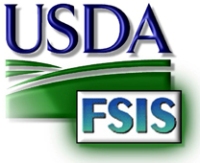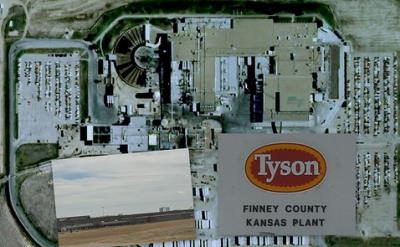 The U.S. Department of Agriculture-Food Safety and Inspection Service (USDA-FSIS) has completed a two-decade initiative to transition from the 1905 Upton Sinclair organoleptic inspection era into modern statistically-based scientific evaluation of microbial status. The FSIS introduced the Hazard Analysis and Critical Control Point- Inspection Models Project (HIMP) in 1997 for poultry and subsequently in 2006 for hogs. Essentially the FSIS has justifiably reorganized their approach to inspection to concentrate on microbiological hazards and has de-emphasized individual carcass inspection by FSIS personnel to detect physical defects. By introducing process control and bacterial standards, food safety has been improved. Individual processors are now obliged to introduce HACCP programs and to undertake greater responsibility for product quality. USDA-FSIS inspectors
The U.S. Department of Agriculture-Food Safety and Inspection Service (USDA-FSIS) has completed a two-decade initiative to transition from the 1905 Upton Sinclair organoleptic inspection era into modern statistically-based scientific evaluation of microbial status. The FSIS introduced the Hazard Analysis and Critical Control Point- Inspection Models Project (HIMP) in 1997 for poultry and subsequently in 2006 for hogs. Essentially the FSIS has justifiably reorganized their approach to inspection to concentrate on microbiological hazards and has de-emphasized individual carcass inspection by FSIS personnel to detect physical defects. By introducing process control and bacterial standards, food safety has been improved. Individual processors are now obliged to introduce HACCP programs and to undertake greater responsibility for product quality. USDA-FSIS inspectors  underwent retraining to operate off-line transitioning from “look and sniff” to monitor company sanitation and processing procedures and to evaluate microbiological data in addition to supervising procedures proven to reduce contamination.
underwent retraining to operate off-line transitioning from “look and sniff” to monitor company sanitation and processing procedures and to evaluate microbiological data in addition to supervising procedures proven to reduce contamination.
Based on improved poultry processing technology, including the introduction of machine vision and modules that replace human hands, the rate of first-processing can be increased from the conventional 1990s rate of 140 birds per minute. The limitation on line speed is a function of the capability of human inspectors. A rate of 170 birds per minute is practical and achievable applying current technology, benefitting processors and ultimately consumers. Operation of HIMP from the early 20 pilot programs, resulted in improvements in both organoleptic and microbiological quality. The extension of the program based on the advantages demonstrated, understandably created a sense of job insecurity among FSIS inspectors, many of whom resisted retraining and the pressure to acquire advanced knowledge. Disaffected inspectors found common cause with organizations opposed in principle to intensive livestock production.
Following success with HIMP in chicken plants, USDA has transitioned from traditional inspection in hog plants. Public advocacy groups in collaboration with unions have consistently litigated to block changes demonstrated to be beneficial by the FSIS as documented in a November 2014 report with respect to FS1-3 defects and lower recovery of Salmonella from products. The Final Rule on HIMP for hog processing was published in October 2019.
There is now opposition to innovations by extending HIMP to beef processing. In an environment currently dominated by concerns over COVID-19, opponents are intent on blocking the trial program intended for the Tyson Foods, Holcomb, KS. plant. Adoption of HIMP will allow waivers to increase line speed and improve efficiency in addition to upgrading food safety. It is noted that the Holcomb plant was extensively remodeled following a fire in 2019 and incorporates improved facilities and equipment to enhance both quality and efficiency.
Opponents of HIMP maintain that USDA has failed to establish a scientific basis to compare conventional and innovative programs. This is a falacy as denoted by improved microbiological and physical quality as off-line inspectors are now more involved in reviewing HACCP programs. Procedures include improved ante-mortem inspection and adherence to welfare standards, sanitation procedures and overseeing company inspection. The organizations representing workers and public health advocates maintain without justification that a change from traditional organoleptic inspection and increased line speeds are invariably correlated with increased worker injury and a decline in microbiological quality.
It is now incumbent on FSIS to establish confidence in HIMP and future programs through a concerted approach to transparency including publication of data as with chicken and hog plants demonstrating superior levels of food safety. Opponents of 21st-Century processing are creating a web of disinformation and cherry-picking public health data and are promoting other distortions of scientific reality. To claim that the prevalence of campylobacteriosis is attributable to changes in processing is ingenuous given multiple sources of infection. Attacking both industry and FDA epidemiologists and statisticians does not necessarily advance their cause of maintaining outdated traditional inspection.
As with many issues relating to intensifying agricultural productivity, opponents of large-scale livestock production cannot provide a practical and financially acceptable alternative that will feed our nation and supply the export market. Cooperation between the USDA-FSIS and large processors has been productive in poultry and swine processing, and HIMP should now be extended to beef production. Practical improvements in food safety have emerged from programs such as HIMP. We can and will do better based on sound science and a commitment to improving food safety.